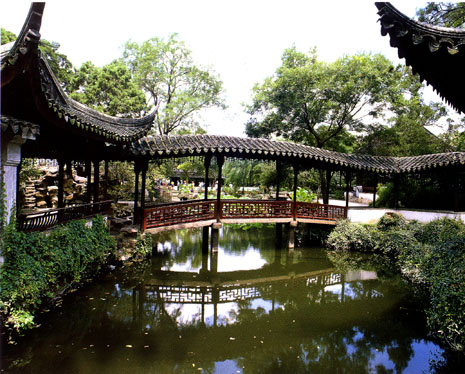Covering 51,950 sq.m,the Humble Administrator's Garden is the largest of all classical gardens in Suzhou . It is centered upon the broad expanse of a lake, making up about one fifth of the total area. With well spaced buildings, the garden landscape and water scape are simple, extensive and natural, possessing the traditional appearances of the Ming Dynasty. It is divided into three parts; the eastern, middle and the western parts. The house lies in the south of the garden.

The middle part is the cream of the garden with marvellous mountains, clear water, exquisite buildings and exuberant trees and flower reminiscent of the scenery in the south of the Lower Yangtze . Lying here and there to the south of the lake are garden buildings and courts in cluster. On an east-west axis there's the Hall of Drifting Fragrance in the middle, flanked by the Loquat Garden Court , the Malus Micromalus Makina court, the Poeny Pavilion, the Listening to the Sound of Rain Pavilion, the small canglang, "A Pure Mind Thinks Deep", and the Magnolia Hall. Rising from the lake are the east and west hills made from a mixture of earth and rocks, and covered with trees. the Prunus Mume Pavilion and the Orange Pavilion stand atop of the hills.By the side of the lake there are forsythias gently stroking the surface of water, and bringing about delightful effects of nature. Much of the surprise comes from the disposition of the Fragrant Isle, the pavilion in lotus breezes and the Mountain-in-View Tower to the west of the lake.from the secluded pavilion of Firmiana Simplex and Bamboo one is able to catch sight of the pagoda of paying debts of gratitude in distance. The picturesque scene of the pagoda mirrored in water is an example of the garden technique called "borrowed view from afar".
The buildings in the western part of the garden are properly arranged by the lake.To the south of the lake is a big mandarin duck's hall with two halves. The northern half is named "the Hall of 36 pairs of mandarin ducks" and the southern half "the hall of 18 camellias ". Built to the west of the lake are the Inducalamus Pavilion, the "With Whom Shall I Sit"?pavilion,the Floating Green Tower, the Stay-and-Listen Pavilion, the Pagoda Reflection pavilion.Going up and down and in a zigzag, a unique veranda over the water is a structure built along the wall to the east of the lake. The Good-For-Both-Families Pavilion on the top of the hill overlooks the middle and western parts, another example of the garden technique called " borrowed view from near".

